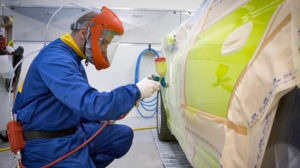If you've watched any of my sales training videos, you've probably guessed from my accent that I’m from the South. A lot can be said for Southerners: we’re great cooks, we’re very polite and friendly, and we love our football. But we are also known for doing things, well, a little backwards sometimes. I was reminded of this just the other day when I was in line at our local home improvement store and the guy in front of me had a shopping cart full of spray paint. I don’t mean a few cans; he had at least a hundred cans of blue spray paint in his cart.
I couldn't help but ask him why he needed all that paint. The guy proudly told me that he was going to paint his car. He just didn't see the need to spend money to get his car freshened up at a body shop.
I can only imagine how his car turned out. I'm sure it will be a real head turner when he’s done.
A lot goes into painting a car. You have to apply primer, then several layers of the actual paint. Finally, multiple layers of clear coat are applied to get the car looking shiny and new.
Sales training is like this as well. To really develop your rep's skills and talents, you need to spend time applying multiple coats of training. Just like a car paint job, good sales training involves at least three elements, each applied in a methodical way:
1) Basic Selling Knowledge
First, you want to make sure that your sales training provides the basic knowledge of good sales techniques. You should make sure that you use some portion of the training program to cover basic knowledge of things like prospecting, qualifying leads, asking good questions, making good customer presentations and handling objections.
2) Practicing Selling Activities
Next, put the basic skills into practice. Have your reps apply the basic selling techniques by doing activities such as role-plays, “what would you do” scenarios, and practicing on smaller accounts. Constructive feedback from managers and peers is important as well as positive reinforcement of the good things the rep is doing.
3) Assessment
Finally, have your reps diagnose their efforts by rating themselves on how well they perform across all steps of the selling process. An obvious approach is to do this right after a sales call, but don't miss opportunities to encourage self reflection after a deal closes. These pursuit postmortems are a must on lost deals, and surprisingly insightful even when there's a positive outcome for an opportunity.
The point is, think about good training a little like painting a car. It takes a very methodical approach to getting reps up-to-speed and always requires multiple sessions and different techniques.
Unfortunately, over and over again, we see companies bring their reps into the corporate office for a few days of sales training without any other planned activities to reinforce the learning. This is comparable to my buddy wanting to use spray paint to put one layer of paint on his car. You can do it… but the end result will be less than ideal.
About The Author
 Researcher, consultant, and sales leader, Brian uses a data-driven approach to drive sales effectiveness. His clients include leading sales organizations in financial services, technology, healthcare, and professional services. Using insight from academics and change management, Brian helps senior leaders and sales enablement teams understand and succeed in today’s more demanding market. His research has been published in Harvard Business Review and other outlets.
Researcher, consultant, and sales leader, Brian uses a data-driven approach to drive sales effectiveness. His clients include leading sales organizations in financial services, technology, healthcare, and professional services. Using insight from academics and change management, Brian helps senior leaders and sales enablement teams understand and succeed in today’s more demanding market. His research has been published in Harvard Business Review and other outlets.




